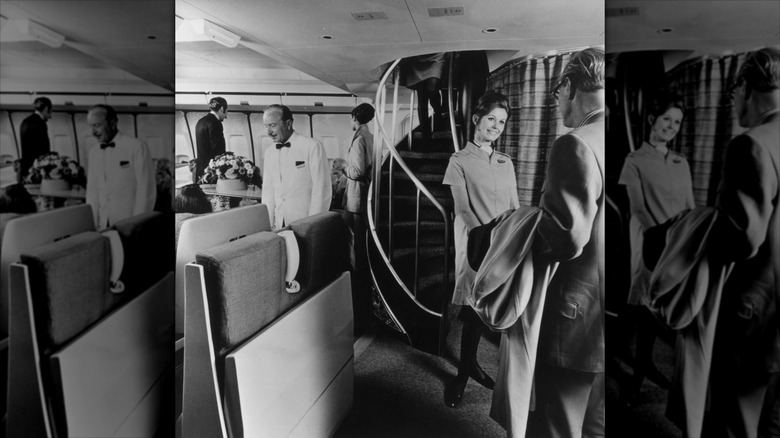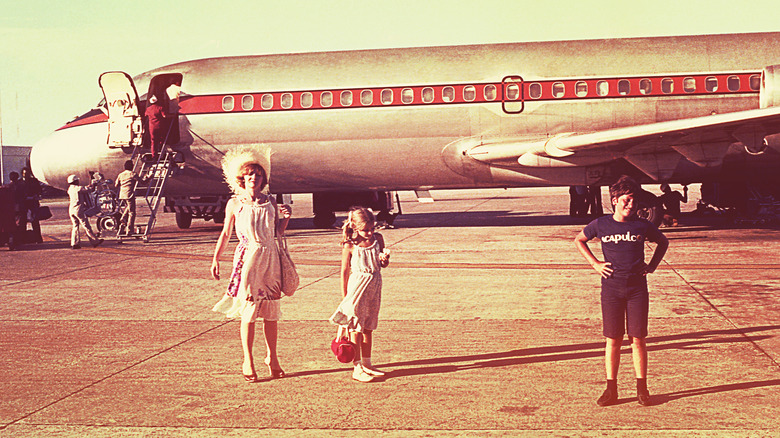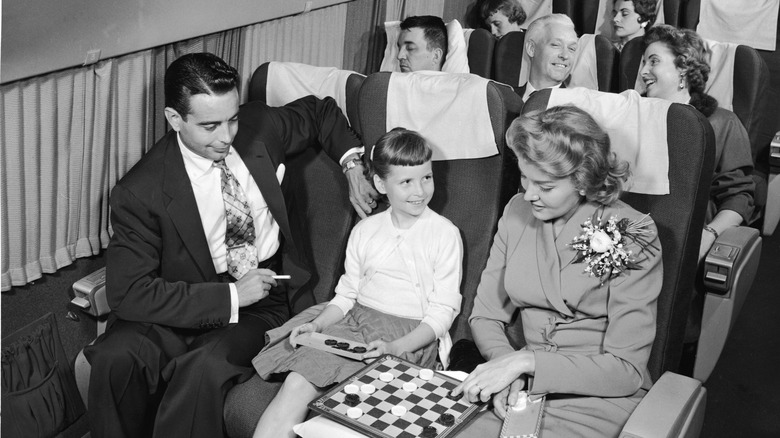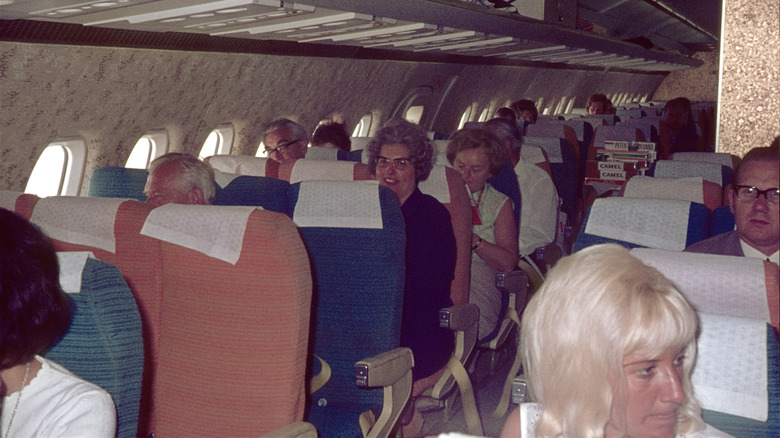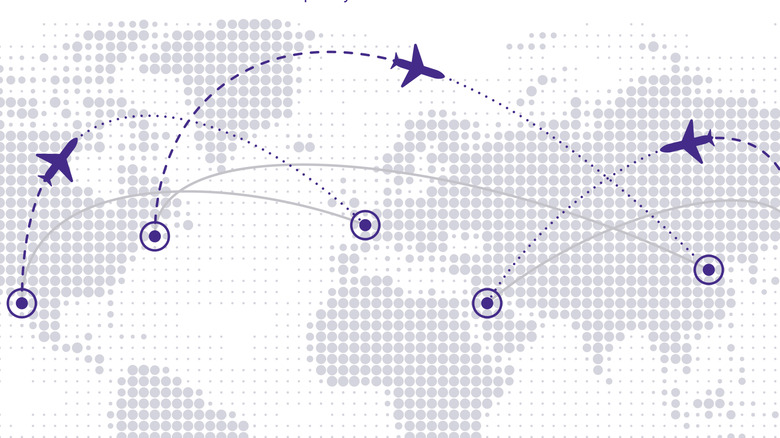5 Ways 1970s Air Travel Was A Totally Different Experience Than Today
In the decades since air travel was first introduced, flying across the world has become the norm. According to the Federal Aviation Administration (FAA), over 44,000 flights land or take off from U.S. airports, ferrying more than 3 million passengers daily. It's a far cry from the highly exclusive and luxurious flights of the golden age of commercial flying.
The world's first commercial flight carried exactly two people, including the pilot, from St. Petersburg, Florida, to Tampa, Florida in 1914. By the 1950s, air travel had become more refined, catering exclusively to the rich. The period spanning the 1950s to the 1970s would go on to be known as the golden age of air travel, thanks to its luxurious flights, free-flowing complimentary alcohol, and a laissez-faire attitude towards security.
Flying in the '70s was a completely different experience compared to today. Air routes were limited, and airline employees would write down passenger details on a ticket jacket. A combination of airline innovations and a growing competitive market made tickets cheaper than they had ever been before, while the soft product — meals, service, amenities, etc. — remained top-tier. These five things were actually really common parts of flying in the 1970s, even though they're unheard of today.
Luxury experiences were the norm, even in coach
For many flyers, the luxurious experience of flying in business or first class is a pipe dream. We despondently scroll through reel after reel of people enjoying glasses of champagne in recliner seats or relaxing in their private suite onboard. And then we switch tabs and book tickets in economy class.
But flying coach in the 1970s was a very different experience. Air travel had evolved into an exclusive affair in the '50s, with sky-high ticket prices and limited seats. But the introduction of the wide-bodied Boeing 747 revolutionized air travel. Airlines suddenly could accommodate more passengers at lower cost, making air travel affordable to the upper middle class for the first time in history. This led to ticket prices falling dramatically while the air travel industry became more competitive.
Instead of price and flight routes, service and quality became the focal point of airline marketing, and people treated flying like the luxury it was. Even travelers in coach enjoyed custom cocktails and filet mignon in fine silverware. Airlines recreated luxury lounges onboard, in which passengers could enjoy unlimited drinks while catching up with each other on comfortable couches. Everyone wore their Sunday best, from lovely dresses and mink coats to distinguished suits and polished leather shoes. The current trend of wearing sleepwear on a flight was an absolute no-no in the '70s.
Security was non-existent
Imagine an airport without the long queues of people waiting to get past security. Doesn't even sound like an airport, right? Yet, this was the norm in the 1970s. No long security checks. No TSA agents looking at you suspiciously for perfectly normal behavior — the TSA didn't even exist until 2001.
For those of us who grew up in a post-9/11 world, it seems inconceivable that airports didn't have security 50 years ago. In a Reddit discussion about this topic, one comment claimed you could just run through the airport just before your flight because there were no security screenings. Another user on Quora detailed his experience coming home from Vietnam to Los Angeles with a trophy rifle. He was allowed onboard with his rifle; a flight attendant stowed it away for him during the flight, and he got it back just before leaving the plane. "A security officer [at LAX] asked to see the rifle. He took it ... did some mock aiming and said he wished he had one, then handed it back to me," the traveler revealed.
The first foray into airport security screenings came in the mid-'70s, when U.S. airports adopted Annex 17 of the International Civil Aviation Organization, according to Sofema Aviation Services. This introduced bag checks, metal detectors, and passenger profiling in response to a surge in hijackings.
People smoked cigarettes inside the flight
Airline etiquette has gone through a radical transformation in the last 50 years. There are rules to being a good passenger today that would get any 1970s passenger thrown off the plane. One of the biggest differences between modern flights and 1970s flights is the attitude towards smoking.
Smoking was incredibly common between the 1950s and 1970s. An estimated 42% of all adults in the U.S. were smokers in 1965, according to research published in the journal "Cancer Epidemiology, Biomarkers, and Prevention." Despite smoking being conclusively linked to cancer as early as the 1950s, tobacco companies pushed back by hiring medical professionals to downplay its effects, so public smoking continued to increase through the '70s. As a result, it was common practice to smoke freely everywhere — including inside the plane.
Airplanes in the '70s had dedicated smoking sections. If you've ever flown in older planes, you may have noticed that some planes had ashtrays built into the armrests. Accounts on Quora and Reddit from people who flew in the '70s often describe stuffy, miserable flights filled with smoke, with passengers taking a drag from their cigarettes throughout the flight. Today, airlines strictly ban any form of smoking or vaping within the airport or the plane, which is one change from the '70s that many passengers are actually happy about.
It's not your imagination — seats actually are smaller
We've all grumbled about the small and cramped seats on flights, particularly in economy. Even though some airlines are investing in better economy seats today, flying was a much more comfortable affair in the '70s. You didn't have to sit cramped in tiny seats with barely any legroom; larger seat sizes were the norm. Most seats on long-haul flights were around 18 inches in width, which has since gone down to 17 inches in an effort to fit more seats in economy (via Texas Back Institute). A one-inch difference may not seem like much, but it leads to less shoulder and elbow room, less room for anyone with wider hips, smaller aisles, and a lot more bumping and rubbing shoulders with strangers.
Perhaps more important than seat width is seat pitch. Seat pitch is the distance between one seat and the seat in front of it. While seat sizes haven't changed much, seat pitch certainly has. U.S. Senator Chuck Schumer pointed out that seat pitch has reduced from an average of 34 inches to 31, severely limiting legroom. The change in seat pitch is what leads to that cramped feeling on economy flights today. Those who are on the taller side struggle to fit into standard economy seats because the seat ahead of them gets in the way. While there are specific rows that have more legroom, you didn't have to hunt for appropriate seats in the '70s because all of them were roomy and comfortable.
Flights were shorter and more expensive
You'd think that air travel 50 years ago would have been a slow, cumbersome process. But the truth is that airlines had mostly figured out the operational challenges of air travel by the 1970s, making it faster and cheaper than in earlier decades.
What's surprising, though, is that many routes in the 1970s actually took less time to complete than they do today. For example, the Sydney Morning Herald reported that flights from New York to Houston took an average of 2.5 hours to complete in 1973, while the same route is just under 4 hours long today. One reason why these routes may take longer than they used to is a focus on fuel efficiency. In a video, Business Insider explains that fuel prices went up from $0.70 per gallon in 2002 to $3 per gallon 10 years later, increasing operational costs for airlines. The easiest way for them to remain competitive was to fly slower, using less fuel and arriving at the destination later.
The opulence and convenience of 1970s air travel were reflected in its price. While tickets were cheaper than earlier decades (and seat selection, meals, and checked-in luggage carried no additional costs), flying was still more expensive compared to today. Simple Flying reported that the average cost of a flight from New York (JFK) to Los Angeles (LAX) was $150 in the 1970s, which works out to over $1,000 today when adjusted for inflation. Meanwhile, flights on the same route average $300 in today's money. While air travel had become more affordable for the upper middle class, it wasn't until the Airline Deregulation Act of 1978 that air travel became affordable to the masses.

